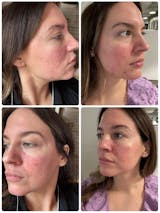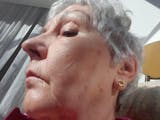
To scrub or not to scrub… these days, scrubs, pore strips, and especially clay masks are all the rage. It’s tempting to believe that these products can wear down or suck out the clogs in our pores.
However, as fun as these products are, these measures alone are usually ineffective at clearing pores or reducing acne because they do not address the underlying mechanisms which clog pores and trigger acne.
Let's examine this item by item:
- Clay masks can be effective to soak up sebum on oily skin. However, it does little in slowing down sebum production nor does it reduce dead skin that is being produced inside the pore. Masks momentarily soak up oil and condition the surface of your skin but you’ll need to get deeper to clear out pores and stop breakouts.
- Scrubs are effective at removing dead skin outside of your pore. However, it does little to remove the dead skin inside your pore (see below illustrations), which is usually what causes clogs and pimples in the first place. Use scrubs to slough away the dull/sallow layer of dead cells on the surface of your skin but if you have active breakouts, scrubs may worsen acne because the abrasive particles can irritate and further inflame acne lesions. Wait until pimples have subsided before reaching for the scrub jar.
- Pore strips use adhesive materials in an attempt to pull out plugs from their heads. On the off chance, these strips may be effective at grabbing an exposed plug. However, most plugs exist under the surface where strips cannot reach. Furthermore, strips do not address the underlying issue which cause plugs to form (see below).
The heavy-hitter: When it comes to hitting the root causes of clogged pores and acne, you'll need a formulation that is gentle enough to be left on your skin all night. This allows the formulation to penetrate deep into your pores delivering the ingredients that flush out dead skin and removing the material that creates plugs.
Clear Out delivers medical-grade ingredients deep into your pores to flush out clogs and thereby stopping acne from occuring:
Let’s dive deeper and understand how acne forms. Every pore is lined with skin that (over time) will die and shed off.
Normally, these dead skin cells would be carried away by sebum, aka our natural facial oil.
However once sebum is mixed with dead skin cells, it creates a sticky substance which could form a plug in our pores if it is not quickly flushed out. Our Clear Out was designed to keep the dead skin out of the pore thereby reducing the material that forms plugs:

If dead skin inside the pore is not cleared out, it mixes with sebum to create a sticky plug underneath the surface of the skin. These microcomedones are not visible to the naked eye:

P. acnes bacteria, which feeds off sebum, begins to flourish in the buildup. The bacteria create a biofilm within the hair follicle and produces several pro-inflammatory chemical signals that trip the immune system to send blood to the tissues surrounding the pore:

As the immune system kicks in full gear, inflammation around the pore accelerates, leading to the dreaded red spot appearing on your face. Enzymes produced by P. acnes may eventually break the comedonal wall. If the rupture penetrates into the deeper dermis layer, local tissue destruction and scar formation become an issue:

We are often asked how one should handle acne when the red spots have already appeared.
At that point, the inflammation chain reaction has already set in motion and little can be done to alter its course. Reducing the inflammation may help, but the comedone trapped inside still needs to be worked out.
The key is to prevent the cycle from starting.
Clearly’s dermatologists created Clear Out as it uses three different active ingredients to hit acne from different angles. As we stop new breakouts from forming, use Lighten Up to reduce the appearance of red post-acne marks and hyperpigmentation.
More on this in our next posts!






